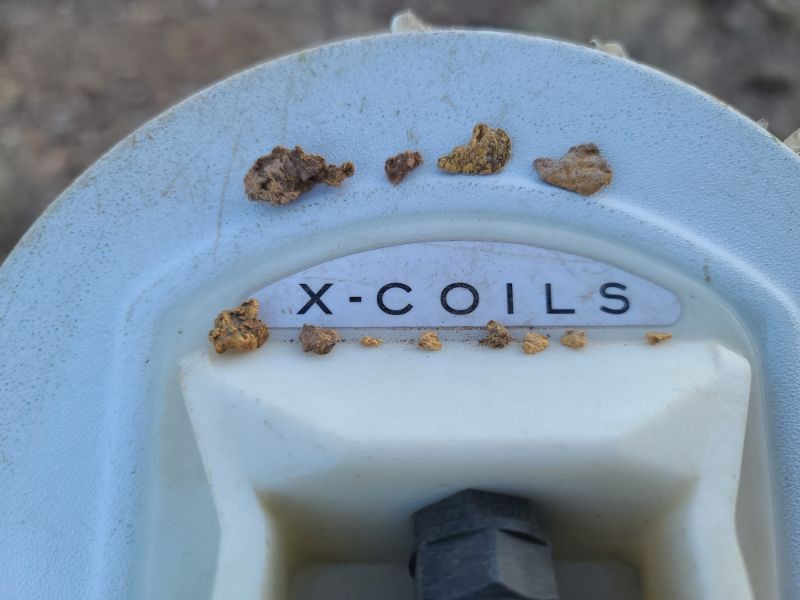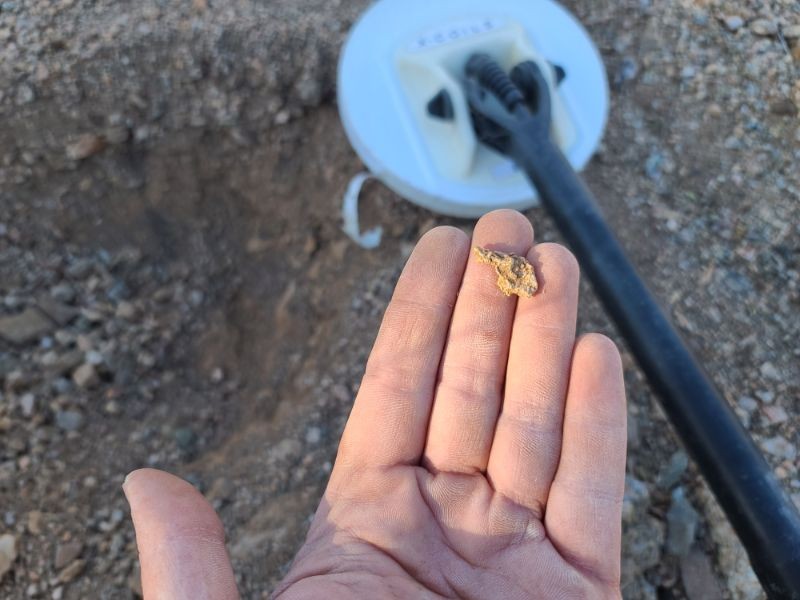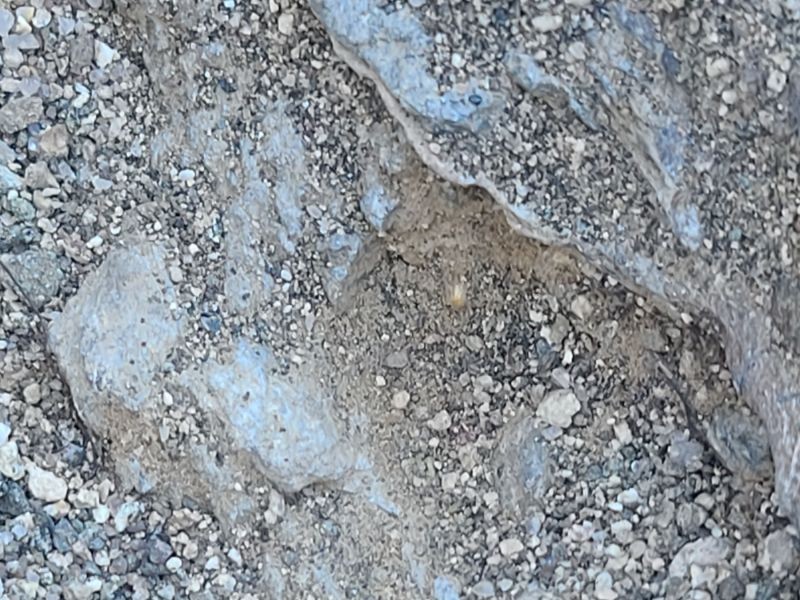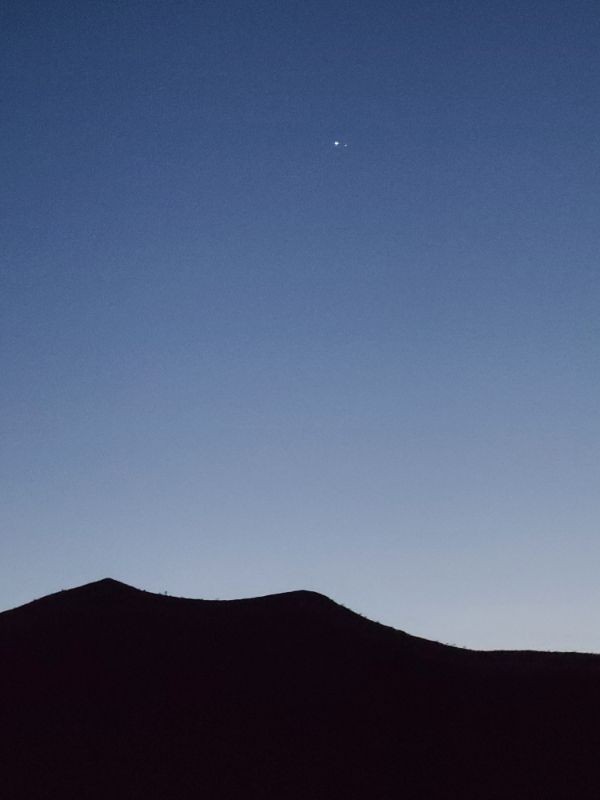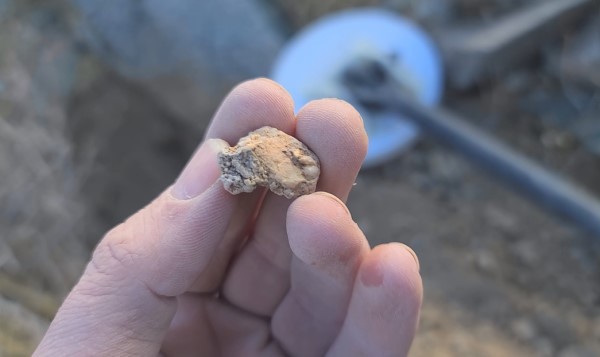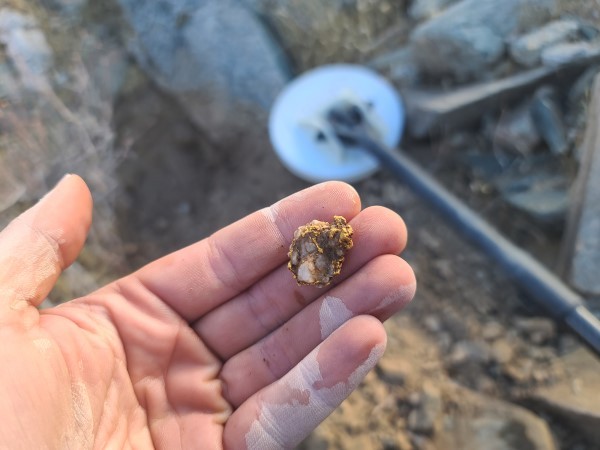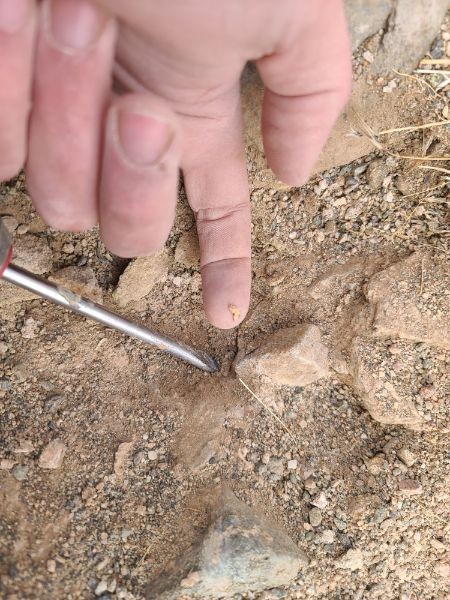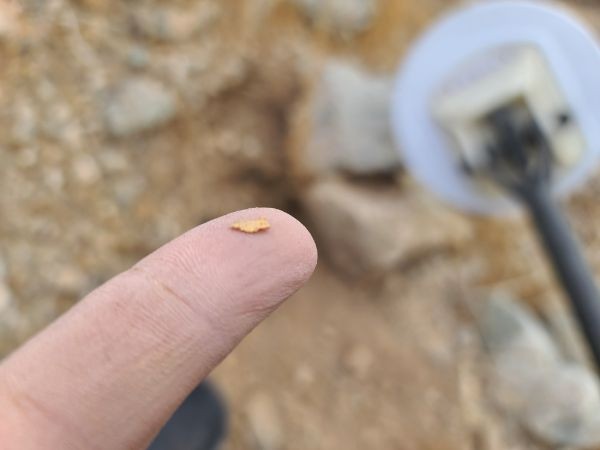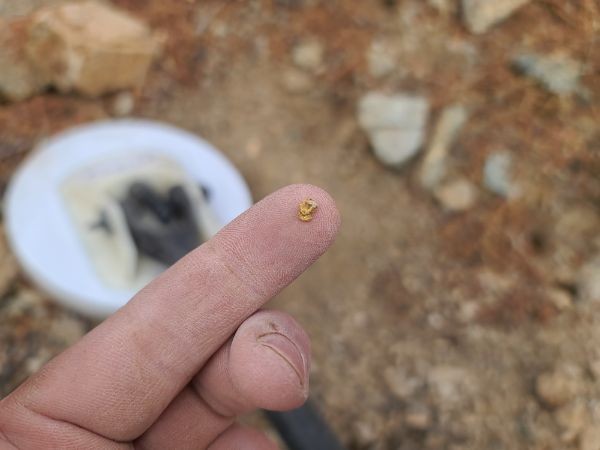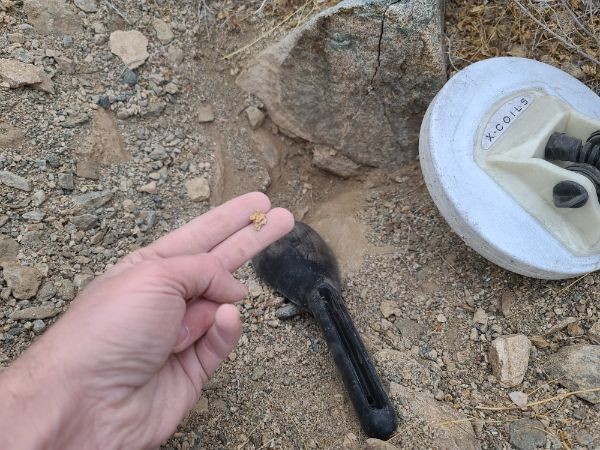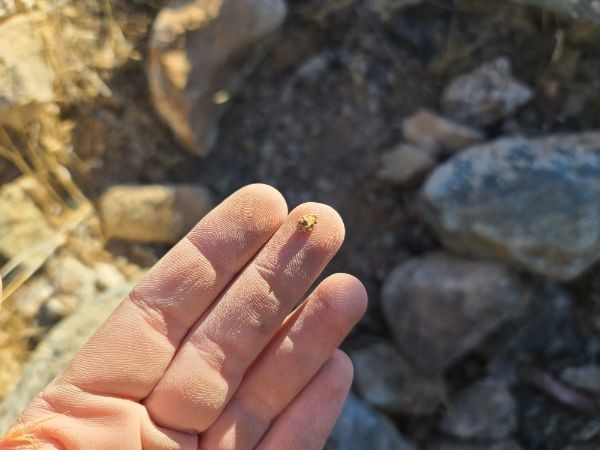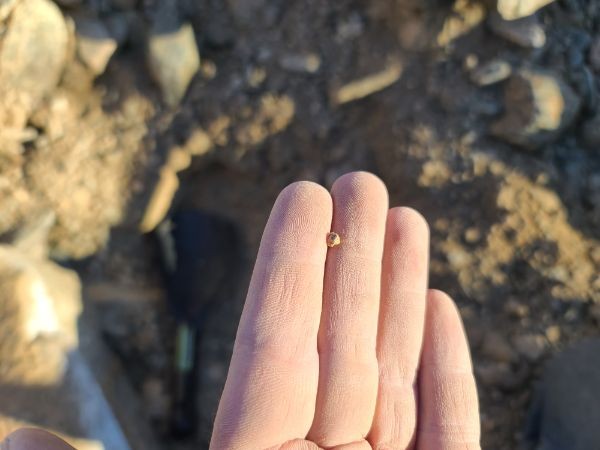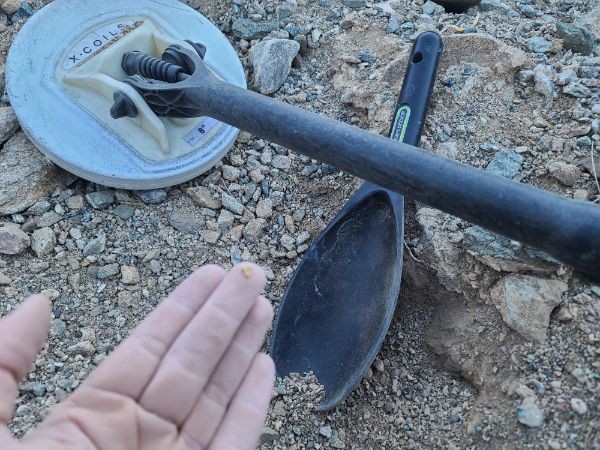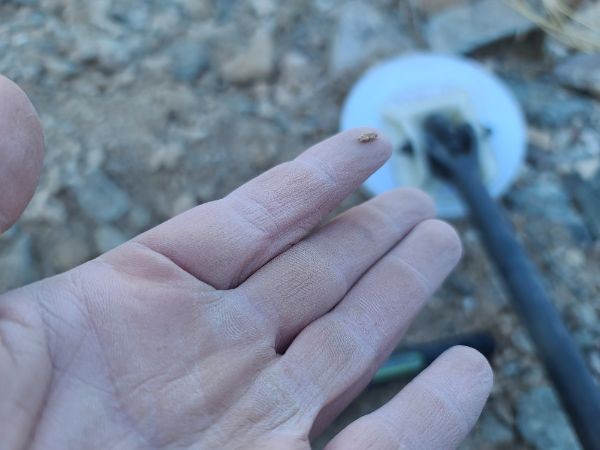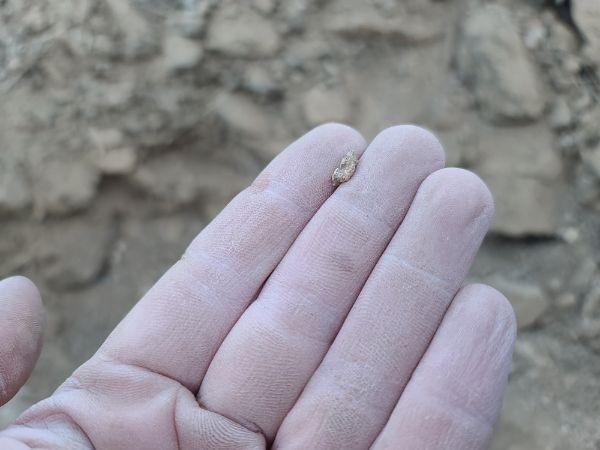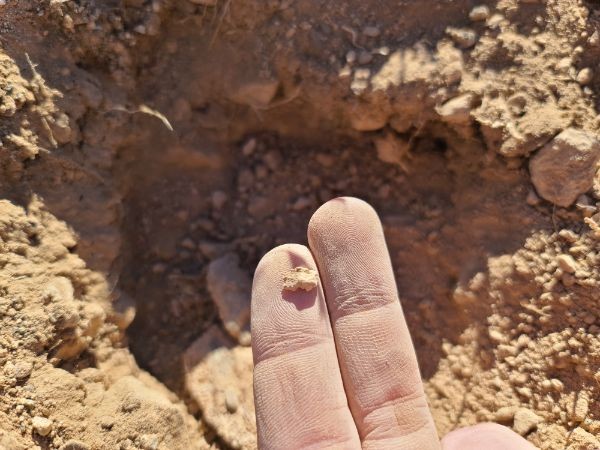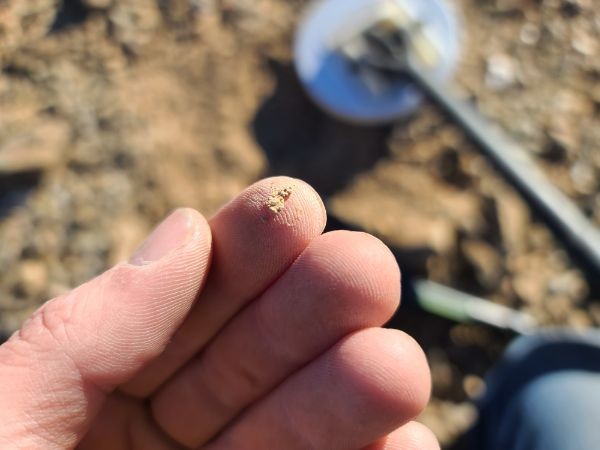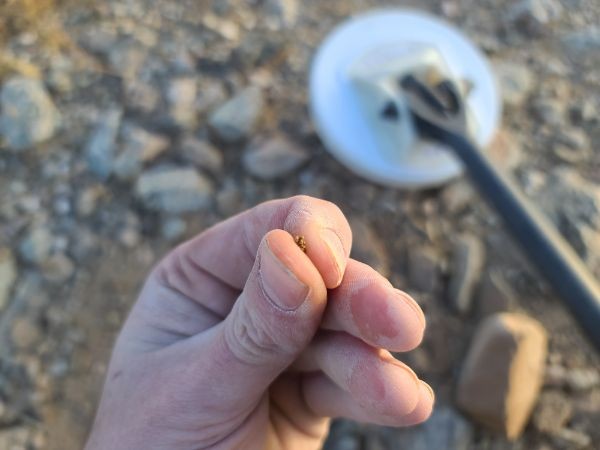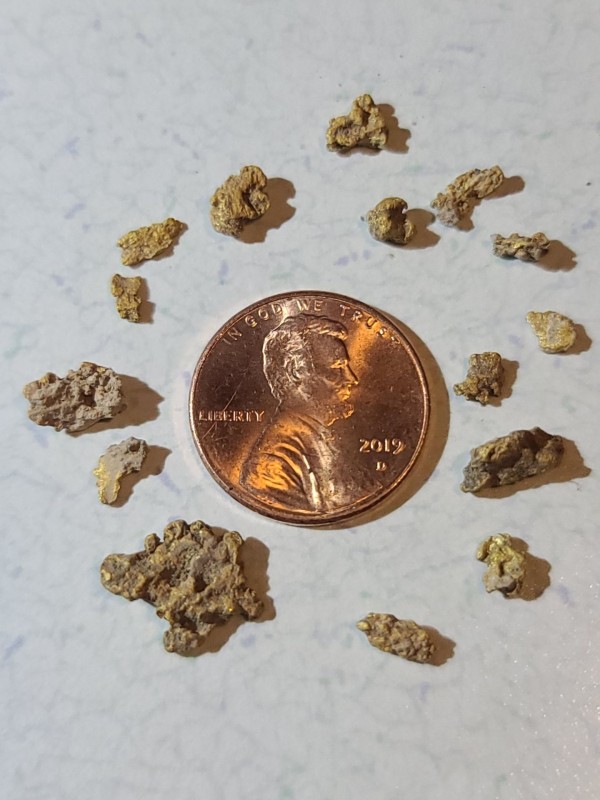-
Posts
2,465 -
Joined
-
Last visited
Content Type
Forums
Detector Prospector Home
Detector Database
Downloads
Everything posted by jasong
-
This. 😄
-
Back of napkin calculation from a formula I just derived which I can explain later if this weight isn't totally off in left field in the end. 🙂 I have no idea if this works or not. (19g/cc * x)+(3g/cc * y)=125.8 g----> x = 25.5 - y So, (19g/cc * (25.5cc -y))+(3g/cc * y)=125.8 g Solve for y (volume of quartz or other material) = 358.7/16 = 22.42cc Now x (volume of gold) = 25.5-22.42 = 3.08 cc Gold weight --->3.08cc *19 g/cc = 58.52 grams Quartz weight ----> 22.42cc*3g/cc = 67.26 grams Rounding error due to me being lazy.
-

Minelab GPX 6000 With Geo Sense Pulse Induction
jasong replied to Steve Herschbach's topic in Minelab Metal Detectors
Take this stuff with a heavy grain of salt. I don't know this person too well, they coulda been hoping I'd post misinformation online for all I know. 😄 -

Minelab GPX 6000 With Geo Sense Pulse Induction
jasong replied to Steve Herschbach's topic in Minelab Metal Detectors
Well I talked to a person who might know such things (or might not) told me they know what Geosense and the 6000 is, and they said my expectations are too high. 🙂 Valentines day release in the US likely (Sunday? Seems odd). $6000 also most likely. Coil cable goes up the shaft or can use old style wrap around. Also, a 3rd player in the GPZ coil market has already made coils, probably enter the market soon. Slightly smaller than 12" first release, not elliptical. Also, a new GPZ is in the works. With one new in demand feature. Tales from the rumor mill. Take with as many grains of salt as necessary. I wasn't told to keep any of this secret, so it's either false or not tightly held. -

8" X Coil In The U.S. - A Field Report
jasong replied to jasong's topic in Detector Prospector Forum
I don't have an SDC to compare with unfortunately, Wes. I have detected a patch here in GB which a Minelab dealer apparantly takes their "experienced" customers to, and said customers worked it for a few years until they felt it was dead, gridded and raked, and I know it's seen a lot of SDC's (and GPZ's). And I was finding stuff about 1"-2" deep, tiny little bits, without too much work, right in the main area 100ft from the road. I have to feel - and this is only a guess - that the GPZ+8" is at least on par to small stuff as the SDC based on this. Maybe more sensitive even. Keep in mind I'm running HY/Normal and able to run high sensitivity though. Not sure how it would work in Motherlode with serps, basalts, etc compared to the SDC. -

Beginners Nugget Patch Location Question
jasong replied to Cascade Steven's topic in Detector Prospector Forum
Rye Patch is more of a general goldfield with many small nugget patches located within and lots of space with little or no gold. You can find lists of goldfields in all the usual well known books. Finding patches within a goldfield is usually boots on the ground, or aerial research. It's pretty rare for anyone to share any kind of actual specific patch location in public. There would be hundreds of people hitting that one specific, tiny spot, every year. It can ruin a spot. The teach a man to fish method is the only way prospecting stays at least semi sustainable and viable. -

8" X Coil In The U.S. - A Field Report
jasong replied to jasong's topic in Detector Prospector Forum
This coil is the "Skunk Buster". Every patch I've taken it to where I knew there was smaller gold to be found, I've found more! Common enough that I don't even need to compare it to the stock coil to know this amount of dinks was just simply not heard by the stock. I am not the type of detectorist that really spends a lot of time going ultra slow and listening for all the little bits. But I have to think that some of the surgical precision detectorists would clean up with this coil in places like Rye Patch (I hope to test this this summer), or in any old patches in AZ that were known to have a lot of small bits and where a person knows just where to grid slowly. Or any deflation surface type patches really. -

Minelab GPX 6000 With Geo Sense Pulse Induction
jasong replied to Steve Herschbach's topic in Minelab Metal Detectors
A thought just occured to me while driving out detecting today and realizing I forgot to charge my battery. Since Minelab engineers read this, maybe it's not too late to include in a 6000. 🙂 Could you get rid of the battery charger for all future detectors and just make them like phones that can charge by plugging into a standard USB C port? That would make it so so convenient since we all usually have a cable laying around somewhere anyways. Or if its too late, can you manufacture a little adapter that goes from battery connector to USB-C? -

Minelab GPX 6000 With Geo Sense Pulse Induction
jasong replied to Steve Herschbach's topic in Minelab Metal Detectors
I'm not doing the best job explaining and using the term "threshold" too generally. They may or may not be making a threshold-less detector, I'm not sure. But the invention deals with this idea: A certain spot has X amount of EMI. Anything above that dB level is generally not EMI. Call it an EMI threshold level. A certain spot has Y amount of ground noise. Anything above that db level is generally not ground noise. Call it a ground threshold level. A given target has Z signal level at a given depth. Call it the target threshold level. The detector itself has a threshold which we call "the" threshold. So, there are 3 threshold levels - X, Y, and Z, and then the general threshold tone of the detector which ideally should be set right below Z and right above X and Y. Any signal which is stronger than the detector threshold gives us an audible signal, and will likely be a target now. A higher threshold seems to serve no purpose since it just adds noise to mask targets now. The invention deals with "channels" (timings?) that allow a user to hone in to the spot where both the EMI threshold level and ground threshold level are nulled out to silent, while the target threshold level is still audible. Wether the general detector threshold itself is audible or not still, I have no clue. Technically speaking, a user would not need an audible threshold at that point though, hence my speculation. But it's not simply adjusting a threshold knob, it sounds like selecting various channels that are better/worse in differing combination at nulling ground and EMI noise, while also maximizing target response. Channel 1 might be bad at ground nulling but good at EMI nulling, and great at target sensitivity. Channel 2 might be just the opposite. Channel 3 might be a combo between nulling ground and EMI. And so on...which is why I said it sounds more like timings. It's specific to your location, tailoring settings and finding the right channel or "zone" to maxmize target sensitivity, which is why I wondered if Geosense might be related to this idea. But again, no idea. Then there is the computer automation of the sensitivity, ground settings, and maybe detector threshold as well, which is a seperate thing. And then the idea with depth sensing/discrim and further signal processing to eliminate noise, which is also seems to eventually lead to operating with no machine threshold as an endgame in my view. But that's just a guess obviously. These could be employed in the 6000, or maybe not for another 5 years in whatever future machine, impossible to say really. But interesting anyways since it seems to indicate the way ML is going with gold machines. -

Minelab GPX 6000 With Geo Sense Pulse Induction
jasong replied to Steve Herschbach's topic in Minelab Metal Detectors
I'm not sure they are getting rid of the background threshold, or maybe making it easier to run a lower threshold or without one if a person chooses, or just adding more control with timings that means you can find the balance between threshold levels of EMI, ground, and targets more precisely and do whatever you want with the background drone we call "threshold" in general. It's really hard to make sense of patent legalese exactly. But it does work on a high end detector - I run my GPZ with almost no threshold so that 95% of what I'm hearing are just the tiny variations which are either EMI/ground noise that jump barely above my threshold level, or good targets. I bump the threshold up just barely above silent though so I still hear the faint background warbles, just not the needless (in my opinion) constant threshold drone. I do pretty good with this style. I see no reason to listen to ground noise personally, my eyes do much better there. This is one reason I liked the 8" X Coil. I could bump up the threshold 8 points and still maintain a nice quiet stability I'm used to. Whcih means to me the coil has a lower noise floor, smaller target signals come through, and I can also run higher gains as a result. Same idea as this invention it sounds like to me. The perfect detector would make no noise at all except on a good target. EMI and ground would be completely silent, this there would be no need to listen to a constant threshold drone if you had enough control finesse to keep the threshold at the perfect balance between EMI/ground noise not coming through, and targets coming through which are above that noise floor. If I'm understanding this patent right, it attempts to embody this sort of detecting theory and allow users further control over it. Bruce Candy has another recent patent too (this one is Wahlrich) which sounds potentially like a new GPZ. But that patent lost me halfway through, it's a difficult read. But it's main focus is on a method to ignore the X component and start sampling way earlier, which means sensitivity to ultra tiny gold among other things. I could be misunderstanding that one too though since it kinda sounds like a PI/constant current hybrid and I'm still not sure I understand if ZVT is different than that or not haha. Detector tech is growing beyond my brain's ability to grasp it these days. -

Minelab GPX 6000 With Geo Sense Pulse Induction
jasong replied to Steve Herschbach's topic in Minelab Metal Detectors
I wonder if this Geosense is going to be unique to gold detectors or is going to be something incorporated into other detectors in the future as well? I was reading the patent filed last month and that one seems to written to apply to all kinds of detectors, gold, coin, and relic. And it makes me wonder if it's related to this Geosense. Yeah or nay, either way, a glimpse into what future detectors might incorporate... It goes over 3 things basically: Combining ground timing and sensitivity controls into one "knob". Or buttons on a screen, etc. The idea being simplifying the need to adjust timings, threshold, and sensitivity with each new location. Automating control of such a "knob" by means of what sounds like a program. Simplified control further by making the onboard computer select the best setting combos basically. Adding fineness to the various timings (channels?) to allow the user to adjust for maximum sensitivity to targets while maintaining a quiet threshold mostly free of EMI and ground noise. Or no threshold at all? I can't tell. But this was something I asked for in 2015 and I hope it's in the the GPZ successor. Give me 2 more timings above Normal, 2 between Normal/Difficult, etc. Sounds like this may be something similar? Maybe I am misunderstanding though. And 3b. sounds like finally some degree of signal processing to further eliminate EMI and ground noise via DSP's. Something I've been wondering on forums for 10 years why no one seems to be doing seriously, given the cheap onboard capabilities that have been available for more than a decade now. The lower your noise floor, the more RX gain you can apply, the more effective depth with the same TX power you can obtain. Also, more talk on the depth discrimination, but really who knows what machines this patent might apply to. The depth stuff might be coin/relic machines. Could be something 5 years from now or could be the 6000. They do talk about "hybrid" VLF/PI machines in this patent. "[0054] Further signal processing techniques may then be used to discriminate the deep target from the deeper target, and to reduce or remove the signals due to soil from the output signal." The more control a machine takes, the more it needs to have consistent, dependable measurements from it's sensors. This might explain some adamancy for rigid coil specifications going in to the future, and the chip? Like, a radar that is off by +/- 2mph might be ok for a police officer catching speeders, but for a self driving Tesla it might mean the difference between safe driving and ramming into the car ahead of it. Just a guess, extreme example, but you get the point... -

8" X Coil In The U.S. - A Field Report
jasong replied to jasong's topic in Detector Prospector Forum
When I get back home, a scale to 3 degrees of accuracy is definitely on my purchase list. I'd like an even more sensitive one like we used in chem lab to start doing my own rough assays with, but those are too clunky and delicate to take into the field. Those ones you can't even breathe on, literally. My scale collection is demonstrative of the evolution of gold machines. I started with one zero (0.x) with my 4500, then moved to two zeros (0.xx) with the GPZ, and now need three zeros (0.xxx) with the new coils. Thankfully, that's as small as I care to detect. 😄 BTW: mono coils scale roughly by area of the coil. The DOD has a similar scaling from what I can tell. The 12" and 10x15 are pretty much equal in area. There are probably other factors to consider with ZVT/DOD stuff though, dunno. 12": 113 in^2 10x15": 118 in^2 -

8" X Coil In The U.S. - A Field Report
jasong replied to jasong's topic in Detector Prospector Forum
Thanks everyone for the comments. Hopefully it's a bit of an advance preview for what a smaller coil can do on the GPZ from whatever manufacturer you choose to buy from. I was in the camp looking for larger coils, but these smaller coils definitely have a place in the arsenal on the GPZ even for a guy who mostly likes searching for bigger nuggets. With the GPX, the most common coil arsenal here was something like - Joey (or ML 8"), 9x14 (or 11x17), and 18" (or 16"/25"). In other words - a shooter coil, a general use coil, and a deep seeker/prospector coil. Unsurprisingly, the same 3 coil types all have a use on the GPZ as well if you work a range of different areas from mountain to desert to prairie. Seems to me that the 10x15 that JW is using is a candidate for the best all around coil size if a person just wanted 1 coil - but I haven't run that coil myself so it's just a guess based on the versatility and useability of the 9x14 on the GPX. I know one thing: you couldn't pay me to put the stock coil back on now! Dave - I know at least one person who has a 12" Z search on order here. Hopefully I'm able to compare the 12" X to Z this Spring or Summer, or maybe this trip if I find an owner in AZ as my understanding is that there are a small number of Z coils here in the US for purchase now. I was hoping I could go test one with a dealer but the limited stock probably makes that infeasible. JW - Like Yoda teaching the young Jedi a lesson. 😄 -

8" X Coil In The U.S. - A Field Report
jasong replied to jasong's topic in Detector Prospector Forum
Ok last update with the 8" and I'm off to prospect new areas with the 17" again. Last year I made the unfortunate discovery that 2 or 3 people had determined where a large number of my patches were at. This year it appears they've found them all. It's only possible by following me or using a GPS tracker. And where I went to pains to leave no trace, and only hiked in, they are absolutely tearing everything up with ATVs, even raking down 6", moving boulders, and leaving nasty trash. Sounds like the same happened to a couple other people I know here too. I give up on that area. Whatever. It might be obvious why I'm not really posting many photos this year now though. Moving back in time to 2016, there is a wash in different area that I have to hike waaaaay in to get to, and I've put off revisting for years because I just don't have the muscle and endurance I used to. I hit it twice with the GPZ/stock coil (and a few times with my 4500). But it was really boulder-y, gave me some 1/4 oz'ers, and the temptation to run this 8" in a spot tailor made for it was too great. So I did the hike today. And finally! No tracks, no dig holes, no trash. No one has found this one yet. This coil still impresses me. But I get the feeling I'm running up against a limit for average size nuggets when the washes get around 16" deep. So I gave up on the lower (deeper) half of the wash. But that's not surprising, honestly to even be hitting 16" with a tiny 8" coil is pretty excellent performance. Something like the 10x15 would probably be preferable in ground deeper than 12" if one had both coils, but that's just a complete guess as I haven't done much testing, just field work. This one ended up 4 grams. It wasn't quite as loud as I expected it to be, which makes me want to run some tests on it because I missed it with my stock coil entirely and it wasn't any more than maybe 10" deep and located in that bedrock crack. Maybe at some weird angle? It also has quartz, but hard to tell when dirty. But I was hitting 1 grammers at the same depth that were screaming louder. Another nugget cozied up into a bedrock crack. Just barely peeking out if you look close. Got this one working between boulders. You can see there is quite a lot more black sand here than in Gold Basin typical stuff. The coil did good in it. The total take for the day. 12.88 grams. If the question is can a person pay this coil off with finds in flogged areas? Then the answer in my specific case (if I had paid for this coil), is "yes!". This puts me at 1.2 ounces with this 8" coil now. Biggest: slightly over 4 grams. Smallest: 0.05 grams. I think my scale only goes to 0.05 grams though - anything 0.01 to 0.05 will always say 0.05. I think the smallest is actually more like 0.03 grams. This is the little coil that people were hoping for. It's just not the cable that people were hoping for. 😄 But again, if you are a serious detectorist, doing this for money or needing to pay your trips off, there is no question in my mind that these are the best way to instantly up your game without waiting. This little guy just paid for all my gas, food, propane, and this month's mortgage payment back home. I'm pretty happy with that since I have to stop working to go detecting. Here's one that won't give a patch location away. It's Jupiter and Saturn together. That's it from me, I'm off to explore for new places again! -

Minelab GPX 6000 With Geo Sense Pulse Induction
jasong replied to Steve Herschbach's topic in Minelab Metal Detectors
Consumer grade GPS is only accurate to 9ft assuming no clouds or trees/obstructions. So there is either more to this Geosense, or its only intended for rough, general ground corrections if this all is what it really is. Many nugget bearing washes are only half that width, and a lot of patches have ground which change drastically over that length. Price wise I still hope it's EQ style, but I doubt it will be. If it's $1500, I'll buy one just on general principal. $4000+ and it had better have something that gives me a good reason to think I can pay it off, or something with enough "wow" factor that I'll try it out with the intention to later resell it after having my fun. -

Nugget Finder Z Search Coil Release Date 18th December
jasong replied to araratgold's topic in Detector Prospector Forum
Were any of these coils sent to US dealers? I called 3 of them in the AZ area yesterday just to see if they had them so I could see it in action, and got voicemails all around so I wasn't able to find out. -

8" X Coil In The U.S. - A Field Report
jasong replied to jasong's topic in Detector Prospector Forum
I'll grab some electrical tape next trip into town and give the cable stabilizer a try, thanks for the recommendation. Did a poking and prodding mission on the benches and in the bushes. Got a couple dinks, one 0.05 grams which I think is about the effective lower weight limit of this coil for my personal uses. Also got this guy from in some rocks around 16" deep if you can believe it, looked like 2 full coil diameters to me including the rocks that were piled and removed, and it was still a great signal. I am going to do a depth test on this piece sometime because I actually think it'll go even deeper which is kinda amazing for an 8" coil. This coil really goes from 0 to scream quickly, there is no mistaking most targets. If I can keep it quiet I can work pretty fast with this little badboy just by listening for fairly obvious signals. I'm guessing 7 grams of gold in this one, but it's really erratically distributed. Out of the hole thusly: And doused in water as so: -

Nugget Finder Z Search Coil Release Date 18th December
jasong replied to araratgold's topic in Detector Prospector Forum
The 2 most asked for requests for a brand new GPZ successor were lighter weight and smaller coils. Here it is, for 1/7th the cost of a new GPZ. With the addition that this coil is reported to get equal or better sensitivity to most common nugget weights. It's like buying a new machine for only $1000. This is a better improvement over the GPZ than the 5000 was over the 4500 IMO (assuming it matches the X Coil performance). I am pretty surprised at the lack of excitement here. Has anyone in the US preordered one or do any dealers here even plan on carrying them? I would have been first in line if I didn't already have a 12" coil. Are people just waiting for a smaller one mostly? -

8" X Coil In The U.S. - A Field Report
jasong replied to jasong's topic in Detector Prospector Forum
My feeling was something like salts/electrolytes in the plants became detectable with a more sensitive coil, but since they are mostly dry I don't know about that either. Maybe it is some sort of static component...added with maybe the coil is sensitive enough to detect small movements in the cable as Simon suggested. Little from column A, little from column B situation? I had a visitor this morning, a guy who's been detecting Gold Basin since the early 90's. I told him I was testing this new coil out so we went to a patch he had worked for 20 years while my coffee brewed. A dealer and their clients also work this area with GPZ's pretty hard, and there are boot scrapes and dig holes everywhere. Snagged 2 little guys in 15 minutes, 0.07 (was ~1inch deep) and 0.09 grams (~4-5" deep). Screaming targets, tested both in situ with his 4800 on sensitive extra and 11" mono and not a peep, but that wasn't too surprising since it's PI. The 0.09 grammer would make the faintest peep when we bumped gain up and turned off stabilization, but it was just a "barely there" sitting on the coil after I dug it and the smaller one wouldn't sound off sitting right on the coil. I think someone is in the market for a used GPZ now. 🙂 Still, shows it's fairly easy to snag a few dinks out of patches that had a lot of production in the past with this coil. -

8" X Coil In The U.S. - A Field Report
jasong replied to jasong's topic in Detector Prospector Forum
Simon - I was wondering if it was my adapter or maybe the cable knocking around, and some may be that, but it definitely zaps when I scrape a rock on the underside too hard, and when I'm poking the coil into bushes it will go off when stuff scrapes against the top of it, and I determined none of that was cable movement. I didn't try running under 18 sens though, and I only ran at 18 sensitivity for maybe the first 2 minutes since I realized quickly this coil was quiet (EMI-wise), the rest was all 20. Oh also, I can mount my AT pinpointer on my backpack with this coil, no problem. The GPZ does still set my pinpointer off in a feedback loop if I get it too close, but oddly it only seems to do it when I'm in black sand laden wash bottoms. It will interfere but then stop when I move the coil if I'm in mellow soil. JW - Hey good to see you post again. These coils feel to me like the equivalent of having a GPZ 8000 in a way, it's a noticeable advantage over the stock 7000 in basically every measurable way. If NF comes out with a range of coil sizes I think people will understand what we've all been talking about. 🙂 My experience with the GPZ in Arizona tracked similar to your story above - in so much as I revisited a lot of GPX patches and found a few nuggets here and there with the GPZ. But the amount of nuggets I missed with the stock GPZ and later found with the various X Coils (mostly the 17") + GPZ was far greater than what the stock GPZ found that my 4500 missed. I feel that if I took this 8" to every good wash I've ever found I could probably pull up 200 or 300 little nuggets I missed with the GPZ/stock coil. That is Arizona gold/ground though. Nevada is the big question mark in my head. I haven't run an X Coil of any size there because the spring-fall months are really hard for me to escape work. I really want to see what the 8" does up there wet, and the 17" dry. Lacking a GPZ successor on the horizon, lacking a range of NF sizes, and if the GPX 6000 doesn't improve heavily on the 7000, then an 8 or 10" X Coil and 17" X Coil is probably the best way to maximize detecting performance for anyone fairly serious about such things in the US. That 15x10 looks compelling too based on the NZ reports and good successes, that may be the killer all around single coil. We will see what NF and the 6000 brings though. -

8" X Coil In The U.S. - A Field Report
jasong replied to jasong's topic in Detector Prospector Forum
It really does scream on tiny stuff, the first few surprised me thinking I had 1+ grammers just to find little bitty guys. I was vocally dubious about your claims of the GPZ obtaining parity with the GB2, and I still want to go test it myself, but after using this coil I have to think that gap has been closed significantly and you are right. Though I feel it's still not hitting on stuff 0.07 grams and under quite as hard as the GB2. But honestly, that stuff is like toss back in the wash material to me so maybe it doesn't even matter. What I'd like to test is speci gold, disseminated in quartz and ore pile type stuff. I think the GM1000 and GB2 are still required there but honestly I think think this 8" will hit some of the stuff I thought was out of range. Reason I say it hasn't achieved parity is because Test Wash 1 has a bank in which a lot of black sands and tiny gold nuggets are eroding out of. I can run my GB2 over it and pull out a bunch of 0.02 gram type stuff, and I could hear there was more left when I left it last year. I can pan it and usually get 2 or 3 per pan. The 8" surprisingly heard a few but not as many as I know are there. But it did hear some, and I was unable to recover any because the pinpointer wouldn't hit them, the coil edge wouldn't detect them, and light was getting dim and my patience for tiny stuff was limited. Does your 8" have bump sensitivity to rocks? And vegetation? Mine will sound off on certain vegetation which just scrapes across the coil, not even bump it. Also, does your coil emit a high pitch squeel? I didn't notice it until I dug into a bank and had my coil leaning at head level. It's extremely high pitch and anyone with hearing loss or anyone over the age of 30 or 40 probably won't be able to hear it. But I have great hearing despite 20 years of playing punk and metal drums loudly somehow... I was able to record it on my phone, but I don't want to waste phone bandwidth uploaded it if you heard it too. -
I was sent this coil for free to use and keep by the manufacturer many months ago with no expectations of reviews or anything else, and I had intended many times to test it in Nevada for my own personal use, but work kept delaying me and I never made it. But I was able to finally get free from work and give it a solid 12 hours of run time over 2 days in Arizona since it's winter now. Soils are mild, few hotrocks (more on that in a moment). 40-50F degrees out. Mostly shallow, rocky washes or hilltops I've pounded with the stock and 17" X Coil (as well as a 4500). I consider these spots flogged and dead for my purposes, and so great places to see if new products can find missed gold. My observations were as follows: This coil (as expected with a smaller coil) was noticeably quieter than the 17" coil and the stock coil. I was able to bump my threshold up 8-10 points and still had about the same threshold chatter as I did with the 17" coil. I usually run 18 sensitivity here because I like a very stable threshold and EMI can be an issue, but I bumped up to 20 sensitivity with no problem. The coil ground balanced ok and I ran in auto which seemed to work fine. This coil loves hotrocks, as would be expected when you are running a smaller, more sensitive coil. I was finding hotrocks deep, shallow, and in places I considered more or less hotrock free in the past. Conversely, I hope it will do well in salt, which I hope to test this summer in Nevada. This coil is bump sensitive This coil is sensitive to a lot of vegetation, particularly sticks/twigs and grasses. I'm unsure if it's detecting them or bumping them. This coil screams on tiny nuggets just out of range of the stock coil. It gives decent signal on edge of detection, tiny nuggets that I missed with the 17" coil. The light weight made me very much more prone to lift up and detect side walls, benches, and pick up and poke/prod into just about any place I encountered, from beginning of day to end. The weight didn't fatigue my arm after a half day of swinging, 5 or 6 hours. Much of that time was without a bungee. This coil eminates a faint, very high pitched squeel or buzz if you get your ear close to it Overall, detecting with the GPZ feels a lot more pleasurable and less like fighting your equipment with a coil of this size and weight. I've mentioned it in prior posts, but take my word from experience now - it's not the weight of the GPZ that causes problems, it's the coil. And this 8" coil is almost the perfect weight to counterbalance the GPZ with the shaft fully extended - ie, this is the coil weight the GPZ should have been designed for. I'll take another pound on the control box no problem, but add 100 or 200 grams onto the coil end, that causes fatigue. Swinging the GPZ with this coil (or any coil of this weight) is a pleasure and not oppressive. The bump sensitivity I'm guessing is a relic of trying to cram so much wire into a tiny space that might not be meant for it, as I get the feeling that this coil is pressing the limits of how small a Super D can be built. But it does mean that I have to slow down and really concentrate on not hitting rocks or vegetation, which ends up being ok because this is a cleanup coil where I am going slow anyways. I expected to find a handful of faint, edge of detection signals I had missed with my other coils. But other than a couple nuggets, almost all the signals were bright, some even loud, and all pretty obvious. Even right out in the middle of the wash. This coil hits hard on tiny stuff. I haven't compared it to the GB2 or Gold Monster, but I found stuff down to 0.06-0.07 grams and they were all great signals. Pinpointing these tiny targets with the coil edge can be difficult as the center of the coil is more sensitive. And they are too tiny to register on my pinpointer, especially the porous and not flaky ones. And that is why I think I missed all the nuggets originally which I later found with the 8" - its a lot easier to get the center of the coil over more of the potential ground, especially with obstructions in the way. In the end, I didn't find a lot of missed nuggets in nooks and crannies, most of them were simply next to a rock or other obstruction like a bush which I was able to get the center of the 8" much closer to. Overall this seems like a good coil for working steep areas (Colorado comes to mind), surface patches, tight washes, and banks/vertical surfaces. The bump sensitivity is the only real major downside, so a slow and controlled swing is important with this coil I think. If NF doesn't end up releasing some critical sizes of coils and new detector releases make the GPZ cheaper (and less risky to make an adapter) then serious detectorists may want to give X Coils another thought. Because right now I can't help but feel like with these coils I am running a new detector that no one else has access to in a way, and I'm somewhat surprised more hard detectorists/enthusiasts haven't availed themselves of this opportunity. But, in the same respect I'm happy, because my time is slim and I haven't had a chance to put them over a lot of places I know others would have flogged to death already. My favorite coil by far is still the 17", but if this 8" (and the 10") perform well in NNV then I may change my mind on that. Here are the nuggets I found (weights are estimated) and my recollection of why I thought I missed them originally with all my other equipment but then found them with the 8" X Coil: Test Wash 1, less than 0.1 gram, too deep for other coils Test Wash 1, 0.08 grams, next to a rock and slightly into wash bank Test Wash 1, 0.12 grams, from a boot scrape and I had given up finding this with the 17" for some reason Test Wash 1, 1+ gram, next to a rock and oriented vertically in a bedrock crack, not sure why I didn't hear this on at least 6 or 7 previous passes since it's right in the wash, but it didn't produce a diggable signal with other coils/machines Test Wash 1, .2 grams, in a little ring of rocks, was only a few inches deep though Test Wash 1, .15 grams, too deep/edge of detection, or too close to rocks Test Wash 1, 0.12 grams, no idea, great signal and should have found before Test Wash 1, 0.15 grams, in side of bank, arm was probably always too tired to raise the coil up there Test Wash 2, 0.12 grams, no idea why it was missed before, right in middle of wash Test Wash 2, 0.3 grams, 2ft up wash side Bench patch, 0.3 grams, next to cactus, too deep/edge of detection? Bench patch, 0.08 grams, too deep/edge of detection Bench patch, 0.06 grams, edge of detection That was all of them. Smallest was 0.06 grams and very porous and almost on surface, largest was like 1.1 grams but I forget the exact weight. All total was a little over 4 grams out of severely beat up washes and a patch. Not much, but it did pay for my gas down here at least. I think once stuff gets below 0.15 grams, it's not really worth my time to chase on general principal. But when you need to grind out some finds for gas, food, whatever, and if you have a lot of patches that produced more than 5 or 6 stray nuggets, then this little guy can probably pop up a few more when you really need them.
-
What a great thread! Chalk me up as another person fascinated with what a prospector could do with GPR. Like Steve, I am curious about searching for paleo river channels, buried and lost under sediment, except I am curious about searching for them in Nevada where the soil is quite salty. I see from your chart that salt attenuates the radio waves quite a lot. What sort of depth might a person expect from your GPR in salty/alkaline soils? Does this attenuation decrease when the soil is dry versus wet, when the salt ions are not as mobile, and if so, how much more depth might be expected when the salty soil is dry? Do you have any units in the US to demonstrate in the field?
-

Minelab GPX 6000 With Geo Sense Pulse Induction
jasong replied to Steve Herschbach's topic in Minelab Metal Detectors
Potential issues being when you detect a surface and then doze it, exposing different mineralization. Or when you detect a wash which floods seasonally and alters the areas of mineralization. If it deals with salt better, salt pockets can move around seasonally too as ground and surface water re concentrates it. Seems to me they would have to have some kind of manual override, or something like a "relearn area" button, if this is what Geosense is. Either way, it's something new in the sense we don't see it on any other detectors, so I'm excited to see Minelab innovating and to see how Geosense, whatever it is, works. Early posts on the forum saw a lot of people content with nothing more than a lighter weight or better ergonomics, and that had me scared ML (and customers) be lulled into complacency. -

Forrest Fenn Treasure Was Found In Wyoming
jasong replied to Glenn in CO's topic in Detector Prospector Forum
Looks like the finder was ID'ed in a lawsuit, and it was all real as Fenn had stated. Just saw this in the local Wyoming paper.


